The Toy Spitz - The Pomeranian
A breed portrait
CONTENTS:
Preface
The history of the Toy Spitz
Preface
The usefulness of the miniature forms of our domestic dogs was recognized very early on, which - contrary to what is often heard - are quite robust, resistant and weatherproof. Their alertness and their defense readiness are inversely proportional to their body size. And in times of famine they were easier to maintain than the big dogs. Therefore, small domestic dogs with long fur were bred in many cultures, which were excellent sources of warmth in the cold and drafty homes of bygone times - also due to their normal temperature of around 39 degrees. These were the Japanese Chin in Nippon, the Pekingese or the Shi-Tzu in China, to name just a few examples. The oldest miniature dog in our culture was the Spitz (see “Grave goods from the La Tène period”). Pliny, the ancient gossip columnist, reports that Roman ladies took their lapdogs to bed with them because they were an excellent remedy for stomach aches. This Roman verse speaks of their other services:
"I attacked the thieves,
I let the lovers in,
So could Mr. and Mrs
Be happy with myself."
It is said of such guardian lapdogs that they were trained to bark violently at approaching thieves, while they used to let the mistress's lovers in without any barking. I bet every Spitz, big or small, would still enjoy a job like this today!
The history of the Toy Spitz

As a so-called "lady's dog", the Toy Spitz (in German: "Zwergspitz") used to be popular because, in addition to his cuteness, he was also characterized by its extreme loyalty, affection and alertness. The smallest of the German Spitzes is a very lively, funny fellow, for whom no distance is too far and who, despite his small size, has the courage to bark cheekily at even the largest dogs. They often put up with it because it seems beneath their dignity to call the tiny cheeky badger to order.
In the past centuries, Spitzes were widespread throughout Central Europe, and there was probably no farm or wagon that did not have a Spitz as a guard. Depending on the type of work the dogs were used for, different sizes and colors gradually emerged, which were adapted to the respective purpose and lifestyle of the people. On the large farms, large Wolfspitzes were found, which, with their shoulder height of up to 60 cm, made a great impression on everyone. On the ships and the Dutch barges, the slightly more delicate Keeshonden were preferred, while the Fuhrmannsspitz (Spitz of the coachman), which sat next to the coachman on the box and guarded the load with his life, was always a small Spitz. In the old days, after work, people liked to stop at an inn and sometimes empty one or more jugs of wine. If the farmer fell asleep on the way home (the horse knew the way to its stable at home), the little Spitz watched over the farmer, the horse and the cart. Above all, he looked after the farmer's wallet. He didn't let anyone get there.

At that time, there was only a distinction between large and small Spitz. The large Spitzes included the Wolfspitz and all Spitzes that were not small. At that time, the small Spitz dogs were also known under the generic term “Toy Spitz”, although they weren't even that small before. Their homeland is southern Germany, where they were bred primarily in Mannheim and the surrounding area, Stuttgart and generally in Württemberg. There, they were also often called “Pommerle”, the trivialization of the German word for Pomeranian. Or Spitzer. The Swabian was probably uncomfortable with the word “Spitz”; it was too short, too hard, too Prussian.
In the 19th century, the name "Pommer" (that means Pomeranian) was a collective name for the Spitz types of various sizes. Today, the term has become uncommon. Laypeople in particular only know the more general term "Spitz", which basically stands for all dogs that have erect ears, a curly tail, long hair and are of medium size. The fact that the original German words "Spitz", "Spitzer" or "Spitzhund" are so common and are even used abroad for breeds that correspond to the Spitz type shows quite clearly how long the Spitz has simply been part of life in Germany. The widespread use of these words can also be an indication that the origin of the breed lies in Germany.

In the past, the Toy Spitz had to correspond completely to the Giant Spitz - he was supposed to be the reduced image, so to speak - and only differed from the big ones in its smaller size and more delicate design. His hair always corresponded to that of the Giant Spitz. Back then, Toy Spitz's ears and paws were supposed to be very small and also very finely haired. If possible, his weight should not exceed 4 kg. According to the book "Der Deutsche Spitz in Wort und Bild" (The German Spitz in Words and Pictures), edition from 1937, the Toy Spitz comes from the Giant Spitz and was gradually bred through inbreeding or incestuous breeding of particularly small and delicate animals.
In Germany, the Toy Spitz was neglected for a long time, and it was only when small dogs became more modern that we Germans noticed that we were also breeding wonderful toy breeds. The English and Americans, who recognized the trend towards small dogs much earlier, renamed the Toy Spitz "Pomeranian". In France, he was also named "Lou-Lou de Pomeranie" after Pomerania, and in Sweden it was named "Pomerska Spetsen".

It's always the same thing with us Germans, that we always look at foreign countries with a little envy. The old Germanic disease. Judge Albert Kull put it this way in the “Kleintier- und Geflügelzeitung” (Stuttgart 1898):
"[...] Hand in hand with this progress went the disastrous German tendency to find everything foreign better and more worthy of imitation than what we have ourselves. [...] It is probably little known that this breed ("The Spitz/Pomeranian is meant, author's note) is much more respected and valued abroad than in Germany. So these dogs, which are called Pommers, are much more in demand abroads than here, and you see numerous exemplars at their dogs shows."
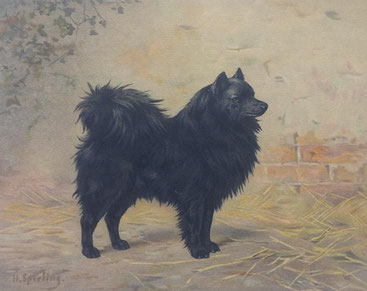
With the advent of organized dog breeding at the end of the 19th century, people began to breed even more specifically sizes and colors, including the Toy Spitz. Before the First World War, they firstly participated in the “Phylax Special Club for Spitzers” and then in the “Zwerghundeclub Berlin”, while after the First World War they were exclusively accustomed to the “Verein für Deutsche Spitzer” (German Spitz Club) until today.
In studbook No. 1 of the German Spitz Club, you can find the first entry of a Toy Spitz under number 52. He was a black male named “Mohrle”. Unfortunately, his date of birth is missing from the entry, but since this dog won first prizes and honorary prizes in 1899, one can assume that he was born before 1897/1898.
In 1922 the Toy Spitz was officially renamed "Kleinspitz" (Miniature Spitz), reason unknown. I have to explain the following: The German name for the Toy Spitz is "Zwergspitz", which has to be translated as something like "Dwarf Spitz". Maybe they simply didn't like the name anymore, because for some people, the term "dwarf" certainly connotes something degenerate or misshapen.

Until 1922 there were only Toy Spitzes that were allowed to be up to 26 cm in height. However, after the name “Zwergspitz” was dropped, the size remained unchanged. Although the reintroduction of the name "Zwergspitz" was repeatedly called for in later years - but this was mainly about renaming the Miniature Spitzes - it took until 1974 until the Toy Spitz was revived.
At the beginning of the 20th century, as with the Giant Spitz, all colors were permitted for the Toy Spitz, with the black one being the one that was best bred. At that time he was also popularly known as the “Mannheimer Spitz” and was quite notorious as a very sharp and very alert coachman's Spitz. In addition to the black Toy Spitz, there were brown specimens - from the lightest light brown to the richest chocolate brown - as well as gray, fox red and steel blue Toy Spitzes, as well as orange and piebald ones. The white Toy Spitz should not be forgotten, which the German Spitz Club considered to be "the most beautiful and noble", at least that's what it says in a Spitz brochure from 1905. At that time, crossbreeding between all colors was permitted, and all animals bred this way were given pedigrees, and they could be sold without any problems. Nevertheless, the breeders remained primarily committed to pure color breeding.
Many famous men and women were (Toy) Spitz lovers: Michelangelo had one as a pet, who sat on a satin cushion while Michael decorated the ceiling of the Sistine Chapel and the little dog made sure that the expensive paint wasn't spilled. Mozart also had a little Spitz and dedicated one of his arias to him. And Isaac Newton owned a Toy Spitz named "Diamond" who liked to help him in his work as a naturalist. More Spitzes with famous owners here.
The Spitz conquers England

Wherever the smallest Spitzes appeared, they immediately found friends. So it is not surprising that they soon successfully immigrated to England - and from England to America. There they were renamed "Pomeranian", but this does not hide their German ancestry, because this name - as already mentioned - points to German area Pomerania.
The first Spitzes came to England in the middle of the 18th century. The earliest evidence of this can be found in an accompanying letter from Princess Charlotte of Mecklenburg-Strelitz dated November 28, 1767. Charlotte was the wife of the English King George III., and came from Mecklenburg-Strelitz, which lies west of Pomerania. At that time, Charlotte gave Lord Haarcourt - who negotiated the marriage between Charlotte and George in 1761 - a pair of "Pomeranian Dogs", which she had imported directly from "Pommern" - Pomerania. They were called “Phoebe” and “Mercury” and were favorites at the English court. Both were also very often depicted in the portraits of the royal family.
After 100 years of English Spitz breeding came into being, Charlotte's granddaughter Queen Victoria (far more committed than her grandmother) dedicated herself to breed the Pomeranian. Her favorite dog “Windsor Marco” was particularly famous at the time. In 1888, the Queen fell in love with the orange-colored Marco in Florence and took him with her to England. However, Marco was quite small for the time, as he “only” weighed 5 kg. At that time, however, a "Pomeranian" was more commonly understood as a dog that was up to 30 cm high at the shoulder - or even taller. Marco, on the other hand, was pretty small.

In 1861, an English guy named John Meyrick wrote the following:" The Pomeranian, unlike the Pug, is a new import into this country, although he has always been known in Germany." He found that the Spitzes were usually white, cream or black and had an average height of 14 inches (around 35 cm). So not very small at that time - and not very colorful!
Victoria exhibited the beautiful Marco for the first time in 1891, which caused a real storm of enthusiasm among the audience. Because of him, the popularity of Pomeranians in England increased massively. Since the demand for small Pomeranians - like Marco - suddenly increased enormously, Victoria primarily advocated for their gradual reduction of size, because next to the delicate queen's dogs, the bigger Pomeranians looked relatively coarse and inelegant.
GM Hicks (treasurer of the Pomeranian Club) wrote in his book "The Pomeranian" (1908) that the breed, which was called "Pomeranian" in England as early as 1890, was known on the continent by a variety of names: Wolfsspitz, Spitz, Volpino, Lupino, Lou-Lou and Pommer.
Only later was the term "Pomeranian" used exclusively for the toy form of the Spitz, which was probably first exhibited in England in 1863 in Chelsea. The animals were not supposed to weigh more than 10 pounds, and any coat color was permitted. In 1905, 124 Pomeranians were registered for an English show - an incredibly high number of entries that not even the most enthusiastic German Spitz lovers would have been able to come up with at the time.

The English "Kennel Club" was founded in 1873 and the first studbook published in 1874 listed the Pomeranian as an independent breed alongside 40 other dog breeds. In 1891 the “Pomeranian Club” was founded, which exclusively ran the Pom.
In order to achieve the gradual size reduction of the Pomeranians, many Toy Spitzes were imported from Germany and crossed into the English lines. As the dogs became increasingly petite, they gradually replaced the large, old-fashioned Pomeranian until the English breed standard set a height limit of 28 cm.
The English once gave the Pomeranian the name “King of Toys". This was probably intended to underline the outstanding position that the Pomeranian had among all lapdogs, because he was truly “fashionable”. And the cheeky little guy has definitely earned this outstanding position.
Spitz hysteria in America

When the Pomeranian finally became "en vogue", they - like many other breeds - began their triumphal march from England to America. The first American Pomeranians were therefore based exclusively on English bloodlines.
However, from the late 1870s onwards, the white German Spitz in particular fell out of favor in the USA. The trigger was the article“ A Whited Canine Sepulcher ” that appeared in the New York Times in 1876. In this pamphlet, the author branded the German Spitz as particularly aggressive and vicious and accused him of the massive spread of rabies in the USA. This newspaper article went so far as to call for punishment for anyone who continued to import the breed into America. The author also suggested the slaughter of all those Spitzes who lived already in the country.
A completely crazy witch hunt began for the Pomeranian, which was considered one of the four most vicious animals in the USA at the time. This witch hunt culminated in the drowning of nearly 800 dogs - locked in iron cages in batches of 48 - in the Hudson River. Since the spectacle took place in public, a huge audience had gathered there to witness the killing of the dogs.
It was only Queen Victoria's public commitment to the Spitz that gradually put an end to this American madness (after all, one was not allowed to criticize the English queen, and she continued to exhibit her dogs as she pleased). Finally, from 1888 onwards, German Spitz could be registered with the American Kennel Club (AKC) for the first time and also shown at dog shows in America.
The entire article about the completely insane Spitz hysteria in the USA can be read here: "The Spitz will be exterminated!"
It seems that the German Spitz was perhaps never known - could never be called - under his real name "Spitz" in America because in this way they tried to get rid of the stigma of the "rabid monster dog" of the late 19th century, which was only given to the Spitz, but not connected to the Pomeranian.
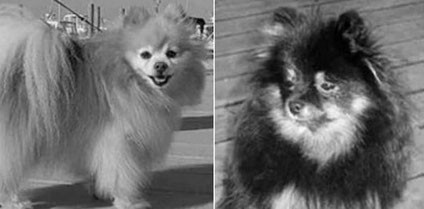
The first American breed standard based almost entirely on the English breed standard. Almost because the American standard of 1900 and the British standard of 1892 differ in certain areas - such as fur colors. However, the US standard of 1916 was the same as the British standard of 1909.
A dog named "Dick" was the first Pomeranian imported into the United States who was registered directly by the AKC studbook. He arrived there in 1888 and in 1892, Dick was exhibited in New York as the first representative of his breed.
The Pomeranian quickly became popular in America at the time, and in 1909 the “Pomeranian Club” became a member of the AKC. By the mid-20th century, the Pom became one of the most popular dog breeds in America.
Interesting fact: Only three dogs survived the sinking of the Titanic on April 2, 1912, two of them were Pomeranians (I'm not really surprised). The dogs were wrapped in blankets and taken to lifeboats number 6 and 7. Presumably "taken" in the sense of “smuggled”. These Poms belonged to Margaret Bechstein Hays and Elizabeth Jane Anne Rothschild.
Personality and training of the Toy Spitz
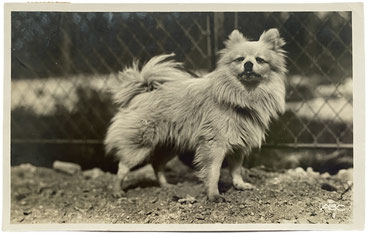
In his nature, the Toy Spitz combines all the positive characteristics of his larger brothers - he is, so to speak, the "pocket version" of the larger breeds. Just don't leave him in the pocket for too long, because then he'll definitely get too warm. 😉
The Toy Spitz is incredibly cute and has the most beautiful fur. He is certainly easy to train, but the prerequisite for this is absolute consequence on the part of the owner, because a Spitz is a Spitz, no matter how big or small he is. Despite his small size, he is also an absolutely reliable guard. And like all Spitzes, the Pomeranian's emotional cuddliness makes him an ideal companion for children and seniors.
👉🏻 I really don't want to praise the Toy Spitz as a fashion dog here, but I would like to have the effect of breaking down certain prejudices. A well-bred Spitz is extremely easy to care for and does not shed more than a short-haired dog, although the short hair is much more difficult to remove than the long hair. He is also falsely accused of having a reputation as a yapper. The proper German Spitz - no matter what size - is vigilant, suspicious and incorruptible, which is what he expresses. However, the Pomeranian is just as trainable as any other dog; excessive yapping doesn't actually have to be necessary. With appropriate training, his tendency to bark can be reduced to a minimum. His behavior as a guard dog also unfairly clashes with his suitability as a family dog. A guard dog is a dog that protects his family 24/7 - and doesn't welcome every strange, shady character or that can be bribed with a treat. Therefore, as a proper family dog, the Spitz has to be sharp and alert if wants to protect his family effectively.

However, the little Spitzes not only bark when they want to tell their master something important, but also out of pure joy in life. This is their way of letting everybody know that they feel happy. Their owners can differentiate quite well between an alarm bark and a happy bark.
Despite all the cuteness, you shouldn't forget that even a small dog is a whole dog. The Toy Spitz is still a watchdog and should be allowed to watch. German Spitzes have been trained to be guards since always, but they were never bred to hunt, so a real Spitz doesn't poach or stray. This makes walks with the Spitz so pleasant, as with the appropriate training he doesn't run away and can therefore be a lot without a leash.
The Toy Spitz is generally a dog that brims with arrogance. His nature is garnished with a self-confidence as big as a barn door. Spitzy's vigilance and his willingness to defend his loved ones are similar to those of the larger varieties. He probably just doesn't know how small he actually is. Maybe he doesn't care? However, one thing can be said freely: "The smaller the Spitz, the cheekier." 😎
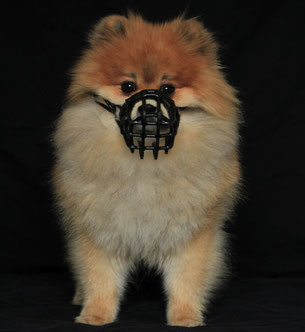
Even the smallest version of the German Spitz is a completely normal dog that likes to move and is quite adventurous. The Toy Spitz loves long walks and is by no means a lapdog, so he doesn't want to be carried around in a bag all day as a child replacement or accessory!
He is perfect for active people who appreciate his funny stubbornness. For people who expect absolute obedience or who have problems asserting themselves or making themselves to be heard, the German Spitz is - no matter what size!!! - not the right dog. Sometimes poorly trained Toy Spitzes command entire families. In this respect, you should not be deceived by the cuteness and smallness of the little Spitz, because even such small dogs can seriously injure their owners. A good example is Goliath, who not only seriously injured his owners, but also the dog control service and is described as "dangerous" by the Hamburg animal protection club itself: Link to Goliath
However, if you begin consistent training when your Spitz is a puppy, you will find an incredibly loyal companion in this breed.
You can find detailed information about the nature and the peculiarities of the German Spitz in my article “The nature of the Spitz”.
The breed standard of the Toy Spitz/ Pomeranian
With regard to the external appearance, the same applies to the Toy Spitz as to all other German Spitz: They all impress with their beautiful coat, which must be off-standing due to the abundant, cottony undercoat in order to be weatherproof. Particularly impressive is the lion's mane-like ruff, from which the fox-like head with the small, quick, almond-shaped eyes looks out cheeky. The short, strong body with the straight back and the moderately tucked belly is elegantly moved through the world on small cat's paws.
The Toy Spitz is daring, and he daringly carries his magnificent curly tail over his back. His chest is broad, his body has good bone strength - but everything is moderate. Under no circumstances should the normal Toy Spitz have the typical American elephant's legs. The legs themselves are straight, with a wide stance, the hindquarters may only be slightly angled.

A real German Spitz - no matter what size - is short and stocky, and with daring attitude, he should basically appear "muff-like". The ratio of the dog's height to length is 1:1.
His forehead is well-rounded and framed by small erect ears, which give him his characteristic, cheeky appearance. The snout must be neither too long nor too short, which is why the ratio of snout to top of the head of the Toy Spitz/Pomeranian is given as approx. 2:4. Unfortunately, this is very often not adhered to, so that many Pomeranians have snouts that are much too short.
The current standard specifies a size of 18-24 cm for the Toy Spitz/ Pomeranian, and the weight should correspond to the size of the dog. In England and America, however, weight specifications are used: there is no upper limit for size, but the weight of the dogs is limited. Dogs can weigh 1.8 to 2 kg and bitches 2 to 2.5 kg. At the dog shows there, however, like here, you usually only see specimens up to around 22 cm.

As with all Spitzes, the stop should be moderate, but never abrupt. Unfortunately, many breeders see this point in the breed standard as merely a recommendation, as an incredible number of Pomeranians have a forehead that is far too rounded (apple head) and therefore a stop that is too pronounced.
The eyes of the Toy Spitz are medium-sized, almond-shaped, slightly slanted, dark in color. Here, too, the reality is often different, as large big eyes, a short muzzle and a round forehead give the Toy Spitz that bear-like appearance that paying buyers are so keen on (Ka-Ching! 🤑). But a dog with this look has little or nothing to do with the German Spitz.
The healthy Toy Spitz has a complete scissor bite with 42 teeth. Since very small dog breeds can have a few problems with their teeth due to their tiny jaws, small premolar losses are tolerated in Toy Spitzes. A pincer bite is also permitted.
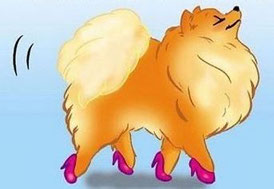
The neck of the smallest Spitz is, like all Spitz, medium long, neither giraffe-like nor so short that it is no longer visible.
About the gait: German Toy Spitzes move straight, fluidly and springily with good thrust. A bit like they were walking in high heels...
The head, the ears, the front of the legs and the paws are covered with short and dense, almost velvety hair, the rest of the body is covered with long off-standing hair that is clearly demarcated from the rest of the fur. The coat is not wavy, curled or shaggy and is not parted on the back. A thick ruff covers the neck and shoulders. The back of the forelegs is well feathered, the hind legs are lushly covered from the croup to the hocks, and the tail is bushy and hairy.

The Spitz's double coat of hair protects him from cold, heat and injuries. It is never (!) sheared down to a few millimeters, that is a sin. Not only does shearing cause immense damage to the fur structure, but the hair often doesn't grow back afterward. A dog like this looks like a plucked chicken for the rest of his life. In addition, in the worst case scenario, the fur loses its insulating ability and therefore no longer provides sufficient protection. The old Spitz is an exception: if his fur bothers him too much in the summer, you can trim it, but you must not shave it down to the skin.
If Spitz dogs are neutered, the fur often degenerates into misshapen masses of coat that are really difficult to care for. Therefore, a Spitz should only be neutered for reasons of illness, but not to make it easier to manage him. This is a terrible, irreversible fallacy.
When it comes to the Spitz’s coat colors, anything is allowed. Be it the widely used orange, be it cream, black & tan, gray and piebalds or the pure colors black and white, which are now on the rise again. Mating of all colors with each other is permitted with the Toy Spitz/ Pomeranian - unlike all other Spitz varieties.
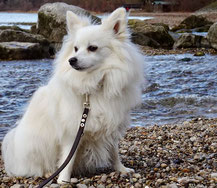
This means that the colors permitted by the German Spitz Club are white, black, brown, orange, cloudy gray and the so-called "other colors", that are considered "andersfarbig" in German: cream, cream-sable, black-and-tan and piebald. Since the previous wording repeatedly led to ambiguities due to its vagueness, it was reformulated to be clearer in the last change to the breed standard. Among other things, this eliminated the need to list the color “merle” separately for disqualifying faults.
So merle is not allowed - and for very good reason: On the one hand, the merle gene is a defective gene and, on the other hand, it has no place in the Spitz, as it was brought into the Spitz-breed through inbreeding with breeds like the Chihuahua. A Spitz in the color merle is therefore not purebred! I would think carefully about whether I would like to spend that much money on a mixed breed dog.
German breeding history of the Toy Spitz/ Pomeranian

After the breeder and judge Joachim Weinberg first made the Chihuahua and then the Chinese hairless dog known in Germany, he turned to the Pomeranian, which he had discovered on his travels abroad. He imported the first dogs to Germany around 1970.
As more and more dogs were imported into Germany over time, the “Verband der Kleinhundezüchter” (German Toy Dog Club) wanted to claim the Pomeranians coming from abroad as their own. However, the "Verein für Deutsche Spitze" (German Spitz Club) could not allow this under any circumstances, as it would have been tantamount to a throwback to the 1920s, when two clubs ran the Toy Spitz at the same time.
The German Spitz Club stated as follows:
"We are the sole representatives of the German Spitzes and have the duty to protect this name from all falsifications. We are later encouraged by the founders of our club, who declared in 1925: "There is no such thing as an English Spitz." Already in the foreword of the breed standard established in 1900 can be read: "The fact that the Spitz was first bred into a specific breed in Germany, and preferably on the Baltic coast, is indicated by the old names of these dogs as "canis Pomeranus", as well as the English "Pomeranian" and the German "Pommer"." [1]
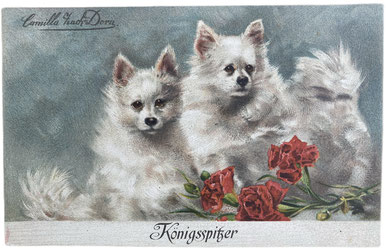
Despite all those pretty arguments, the Pomeranians almost ended up in the German Toy Dog Club: at the last moment and with the significant support of the then 2nd President of the VDH, Dr. Bandel, the main board of the German Spitz Club prevented this. On February 3, 1974, the club expanded its breed standard to include the “Zwergspitz” variety, in order to be able to include the Pomeranian within the Zwergspitz variety.
The change of the breed standard, which was necessary to integrate the Pomeranian, was made without a decision by the general assembly, but only by the then main board at the meeting on February 3, 1974. "We acted over the heads of the General Assembly,” said the Club's then president Werner Jäger. The decision was probably made under pressure from the VDH and led to the expansion of the FCI breed standard. [7]
Even though there was a plan to address the Pomeranian issue at the general meeting in 1975, but in reality nothing happened. The standard change was finished. Done!
By the way, people weren't really that enthusiastic about what kind of dogs came from abroad. The untypical, very high tail position and the frequent apple heads of the imported Pomeranians were criticized, and shortened snouts and jaws were also a problem. Some imported animals were unable to breed at 1.5 years old, and many bitches were only able to give birth by Cesarean section. In 1975, judge representative Wörner criticized these Pomeranians as follows:
"Toy is not the same as gnome. Pomeranians must also meet the binding FCI standard and be completely Spitz. Animals with inadequate temperaments are not the goal of Toy Spitz breeding. "

At that time, the German Spitz Club also had a strong suspicion that Chihuahuas or Pekingese dogs had been secretly mixed into the Pomeranian abroad in order to achieve the desired, doll-like appearance of the dogs. Therefore, mating of Toy Spitzes of German lineage with the imported Pomeranians was initially prohibited. [14]
15 years later, the club was again sobered to discover that the Pomeranians in their homeland were not only not bred according to colors, but that - in addition to a different head shape - they also have a different temperament than the Pomeranians from German lines. As a consequence of these experiences, an application was made in 1987 to recognize the Pomeranian breed as an independent Spitz breed and to separate it from the German Spitzes. [13] In practice, this meant that, according to the wishes of the Spitz Club's main board, the Pomeranian should be considered a separate, foreign breed, similar to the Japanese Spitz or the Volpino Italiano. However, the commission, set up specifically for this purpose, came to no conclusion.
👉🏻 You have to savor this slowly: They noticed that the imported dogs differed very much in appearance and nature from our German Spitz, they even suspected that many of them are not purebred German Spitzes - and they just didn't do anything (apart from a failed try)!
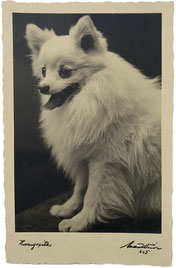
Crossing the foreign Pomeranian into the German Spitz resulted in another, unwanted development in the population of the Miniature and Mittel Spitzes: Since the ancestors of the Pomeranian - as already mentioned above - were a lot larger than the classic Toy Spitz, it is the case that the former size is still anchored in the dogs' genes today. Sometimes, a “throwback” Pomeranian appears in the litters of Toy Spitz breeders, i.e. a puppy that is significantly larger than a Toy Spitz or Pomeranian actually should be.
And currently there are quite a few German Spitzes that have the size of a Miniature Spitz or even a Mittel Spitz, but in terms of type they correspond more to the Pomeranian - and not to the type required by the breed standard for the respective variety, neither in appearance nor in temperament. This is mainly because after the Pomeranian was integrated into the Pomeranian, oversized animals were simply reclassified as Miniature Spitzes or Mittel Spitzes. [2] This is how the Pomeranian (unfortunately) found his way into the Miniature and Mittel Spitz population. This resulted in the fact that the type of those two sizes became extremely watered down - both in appearance and in nature.
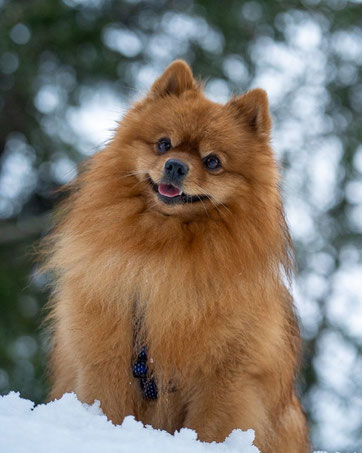
In the case of the orange Miniature Spitzes, for example, more and more type and color purity were lost in the 1980s, as Pomeranians that were too large were simply reclassified as Miniature Spitzes and were subsequently bred with them in an uncontrolled manner.
❗ As far as the Mittel Spitz x Giant Spitz mating is concerned, it is therefore very relevant to ensure that you only use Pomeranian-free lines for this purpose, otherwise you risk breeding oversized "Giant Pomeranians" in the future.
From 1975 to 1985, over 30 Pomeranians were imported to Germany, but there was hardly any demand. This may be due to the fact that the offspring of those dogs was oversized or could not be accepted for breeding because their color was not permitted by the German breed standard. With various breed standard changes in 1985, 1990 and 1997, the German Spitz Club tried to counteract the problems that arose within Pomeranian breeding. Since the number of puppies registered gradually increased, the club's measures were probably successful.
The standard, revised in 1996 by the main board of the German Spitz Club and approved by the FCI in 1997, listed the breed names “Zwergspitz” and “Pomeranian” on an equal footing. This officially recognized by the club that the Toy Spitz is a worldwide variety of the German Spitz, which is called "Pomeranian" abroad.
It was precisely around this point of time that the ladies and gentlemen of the German Spitz Club suddenly noticed that mixing the Pomeranian into the Toy Spitz population actually benefited the Toy Spitz. He was improved through these measures, so to speak. Well....
"The current appearance of the German Toy Spitz has changed a lot compared to the previous phenotype, because the Toy Spitz was once just a dwarfed Miniature Spitz, not very attractive, rather gnome-like. In contrast, the appearance of today's Toy Spitz has become fuller, more muscular and more stable. Thanks to numerous inbred imports from the USA, Canada, England, etc., the current appearance of the German Toy Spitz has changed so positively that it is generally receiving international recognition." [4]
In this case, “international recognition” can easily be replaced by “international buyership,” and then it becomes clearer what it’s all about: money, of course. Because just 11 years ago the same people wanted to separate the Pomeranian from the Toy Spitz and introduce it as a foreign Spitz breed - and suddenly the German dogs are the ugly gnomes? Such a surprise! 🙄
Are Pomeranian and Toy Spitz the same?

No, they are not. Although Toy Spitzes and Pomeranians are officially listed as one breed, they are actually two dog breeds that simply share the same ancestors. Both breeds are closely related to each other and are similar on many levels, but differ greatly from each other in many other areas. A breed characteristic of the Pomeranian, for example, is the feathered, extremely high-set tail. The Pomeranian is the only Spitz dog whose tail is designed to lie so flat and straight on its back.

The breeding lines of the non-continental Pomeranians were separated from the German Toy Spitzes for more than 100 years. The spatial separation of the two caused genetic drift in the respective lines, so that today it is a fact that the Toy Spitz has a different genetics than the Pomeranian in other parts of the world. The Pomeranian, which originally immigrated to the world from Germany as a Toy Spitz, has changed his character and appearance over the decades and over further breeding developments and has clearly split off from his German cousin.
In the 70s of the last century, the Pomeranian became one of the most popular dog breeds in the USA and a so-called fashion dog.
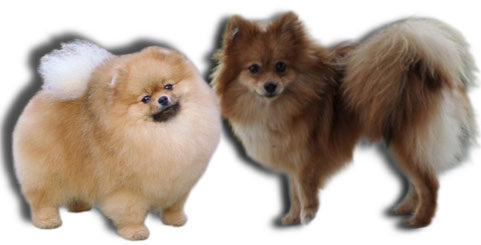
Becoming a fashion dog is never good for the health of breeds of dog, because once a breed is “trendy”, there is an increased demand for it, which increases the price of the puppies. This in turn motivates many owners of the breed to start breeding themselves, as well as it motivates commercial breeders (i.e. "puppy mills"). Due to the fixation on the quick money that can be made with such puppies and the lack of background knowledge concerning the breed, breeding is often done without regard to losses, i.e. without the important health tests. As a result, not only are hereditary diseases and behavioral problems spreading in the "fashion dog breed", but the breed itself is also becoming more and more dissimilar, as people simply want to satisfy the short-term demand of the buyership. And if the buyership wants a dog that looks like a teddy bear, breeders that are only interested in money will breed teddy bears. And so the Pomeranian has changed a lot over the decades.

How do the two breeds differ? Firstly, the shape of the head alone couldn't be more different. The Pomeranian usually has a strongly bulging forehead, which sometimes looks like an apple head, and a much shorter snout than the Toy Spitz. This in turn has a much flatter, wedge-shaped head that looks fox-like, with a longer snout.
The Pomeranian's ears are much smaller and rounder than those of the Toy Spitz and are set very high. Sometimes the small mouse ears of the Pom more or less disappear into its coat, while the triangular ears of the Toy Spitz are always visible.
There are also serious differences in how the dogs hold their tails, as the tail of the German Spitz is very different from the Pomeranian. The Pomeranian's feathery tail lies super flat and straight on his back and is set very high, usually so high that the animal's butt lies more behind the base of the tail. The tail of the German Spitz, on the other hand, is carried curled upwards over the back; the base of the tail is high, but not as extreme as the Pomeranian.
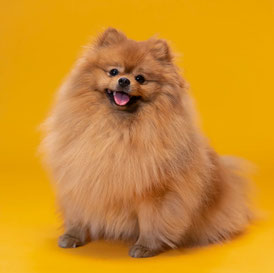
The extremely lush masses of fur make the Pomeranian appear like a thick ball. It is much more lush than the Spitz's coat and therefore requires a lot more care. As with all German Spitz, the areas of the Toy's mane and pants stand out from the rest of the fur. With the Pomeranian, on the other hand, there are no definite coat areas at all, he is simply a luffy ball on legs.
In terms of his mass - or rather his bone structure - the Pomeranian has now achieved such an amount of substance that his legs look like thick stomps.
Where the Toy Spitz has medium-sized almond eyes, the Pom has often more googly eyes... In principle, the list is endless, and so far we have only covered the exterior. As far as the personality of the Pomeranian is concerned, he simply no longer has much in common with the Toy Spitz, as he has been bred exclusively for show and companion purposes for many years. Of course, there are always Poms which are very similar in nature to the German Spitz, but that's not the rule.

So why didn't the FCI recognize the Pomeranian as its own breed, but instead sees it as a foreign German Spitz? This is incomprehensible insofar as the German Spitz Club once tried - not without reason - to separate the Pomeranians from the Toy Spitzes category in order to list them separately as a foreign Spitz breed (see breeding history). Well, now you could say they were just wrong. But this happened exactly the same way, just the other way around, in England:
From the late 1970s onwards, the German Toy Spitz was increasingly imported into the UK in order to revive some of the old pure coat colors (such as the color white) that had been lost due to the complete color liberalization of the British. Since the color white is recessive, it always loses out to other colors.

However, the import of the German Toy Spitzes caused great concern among British breeders and exhibitors, and they didn't really know what to do with the Pom's German cousin. They were already different dogs, the British noticed that too. In 1982 an extraordinary general meeting of "The Pomeranian Club" was held to clarify how to deal with the problem of the imported German Spitzes. Finally, in 1984, the Kennel Club intervened and created a separate registry for the German Spitz. So the English basically had the same problem as us: two dog breeds were mixed together that, although they have common ancestors, no longer have much in common with each other in terms of breeding.
It's a problem that always triggers discussions. So it is not without problems when completely different breed lines compete at a dog show. Unfortunately, the old German lines usually lose out at this point.

The “breeding” of Pomeranians was given even greater impetus by social media. In the early 2000s, a breed representative named "Boo" appeared on Facebook, but he looked more like a soft toy than a Pomeranian. Or like a dog at all. Boo lived in the USA from 2006 to 2019 and had a whopping 16.5 million followers on Facebook. Boo became so famous because he looked like a teddy bear. Unfortunately, Boo massively increased the demand for even more Pomeranians in the doll-like Boo type.
And because this trend wasn't bad enough, further disaster followed in the form of different "variants" of the Pomeranian: Toy Pomeranian (tiny), Teacup Pomeranian (extra tiny), Pomchi (mixed breed of Pomeranian and Chihuahua) and of course the Boo-Pomeranian (also totally tiny). Of course, all of this has absolutely nothing to do with a real German Spitz. But if it makes a lot of money in the cash register, some people will breed everything!
All of these pitiful creatures, which are intentionally dwarfed and which are sometimes not much larger than hamsters, combine two essential factors: they are neither purebred (but usually hybrids of Pomeranians and Chihuahuas), nor healthy. They are really tortured breeds, because the extreme dwarfism leads to a whole series of serious health defects.
Summary

Toy Spitzes are wonderful little dogs. They are self-confident, stubborn and intelligent cheerful natures who can make their people very happy - if you know how to handle them. The Spitz's focus on his family is a trait that his friends value so much about him. His charm, with which he effortlessly engages his family through his playful, friendly and bright demeanor, is almost limitless. The only thing that is more limitless than his charm is his self-confidence, which is why consistent training is absolutely necessary, even for the smallest Spitz variety.
Even though the terms are sometimes used interchangeably, a Toy Spitz is by no means a Pomeranian! Both differ greatly in appearance and in essence. In contrast to the Pomeranian, a Toy Spitz is a real German Spitz, just in the smallest format.
Over time, the real Toy Spitz was almost completely replaced by the Pomeranian. Unfortunately, this is always how it happens as soon as foreign Spitz breeds are brought into our German Spitzes (see the displacement of the Wolfspitz by the Keeshond). Because if different types of a breed of dog have to compete with each other at shows, then sooner or later this will always be to the disadvantage of one type. The current dog shows are massively pushing this "fashionable change" forward, so no one needs to be fooled: the process of displacement is always identical. First, the respective breed of dog is gutted from the inside, i.e. the essential characteristics are softened - they become nothing more than a lapdog, just a useless toy - then the type begins to transform into total trivialization.

The equation of the Pomeranian with the Toy Spitz has not only completely changed the type of the little Spitz, but has also extended to the other varieties: Because Pomeranians that were too large were regularly reclassified as Miniature Spitz or even Mittel Spitz, the doll-like Pomeranian also has changed both sized significantly in exterior and temperament.
Since some Giant Spitz breeders would like to cross Mittel Spitzes into their lines in order to achieve greater diversity and less inbreeding, there is also a risk of watering down the population of the Giant Spitz in appearance and nature - if Mittel Spitzes are chosen which have got Pomeranians in their ancestry.
There is also another lesson in the history of the Pomeranian: As soon as you start mating all possible coat colors together, one color is definitely at a disadvantage, and that is the color white. The white Pomeranians were virtually extinct in England due to the inflationary mixing of all coat colors and in order to breed back the beautiful white Pomeranians, white Toy Spitzes had to be imported from Germany in the 1970s.
That's why it would be desirable if the statement "breeding means thinking in generations" wasn't always quoted, but if breeding was finally done according to this credo. Otherwise, I see dark times for our oldest German dog breed!
Sources
[1] "Der Deutsche Spitz" no. 67, p. 1
[2] "Der Deutsche Spitz" no 159, p. 49
[3] "Der Deutsche Spitz" no. 67, p. 6
[4] "Der Deutsche Spitz" no. 159, p. 48 f.
[5] "Der Deutsche Spitz" no. 70, p. 16 f.
[6] "Der Deutsche Spitz" no. 115, p. 44
[7] "Der Deutsche Spitz" no. 67, p. 6
Pictures
(A) Richard Strebel: Die Deutschen Hunde, Band 1, S. 63
(B) Jean Bungartz: "Handbuch zur Beurtheilung der Racen-Reinheit des Hundes", Verlag Paul Neff, Stuttgart 1884
(C) "Black Pomeranian" from Vero Shaw's "Book of the dog"
(D) "Album edler Rassehunde" by Arthur Seyfarth
(E) https://pin.it/5qrU0VM
(F) https://pin.it/1AderpCkn
(G) https://pin.it/Tb2NRwuvS
(F) https://www.dailymail.co.uk/news/article-5481507/Pomeranian-puppy-floats-balloons-adorable-clip.html
14.01.2024





